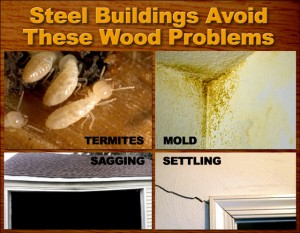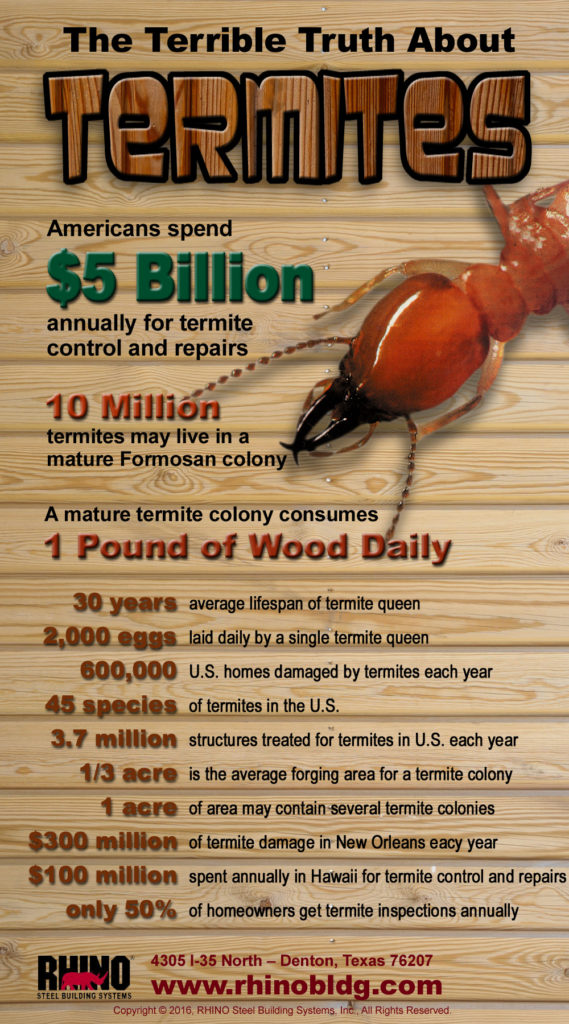More Ways Metal Buildings Reduce Maintenance Headaches
Part one of this series revealed some of the ways steel buildings deliver lower maintenance. Here are a few more ways a metal building reduces the upkeep hassles and expenses associated with wood structures.
 Steel is Impervious to Termites and Wood Ants
Steel is Impervious to Termites and Wood Ants
Wood is the favorite food of destructive termites and wood ants. Lumber-framed buildings require periodic termite and ant inspections— and costly chemical treatments or repairs if infestation is detected.
So how much can termites cost?
- Termite inspections with a written report cost about $75 to $150, depending on location and the size of the structure. If evidence of termites is found, treatment is required.
- Extermination costs fluctuate widely, based on the method and the size of the building. Techniques vary of baiting, to spraying with strong chemical termicides, to tenting the entire structure for complete fumigation. Thus, treatment prices range from $500 to $5,000 or more.
- If termites have inflicted structural damage, repair costs can be shocking. Homeowners average $3,000 for termite repairs— although extensive destruction may cost as much as $8,000. Wood-framed commercial structure owners may easily find termite damage costs mounting to $10,000 or more.
- It is no wonder Americans spend $5 billion annually on termite preventions and repairs.
No termite or wood ant can take a bite out of steel, so that is one less expense to worry about.
Steel is Invulnerable to Mold, Mildew, and Rot
Condensation or water leaks wreak havoc in a wood-framed structure. Mold and mildew feed on organic wood—especially in the presence of moisture.
Ridding your structure of mold or mildew is an expensive nightmare.
- Mold inspections fees run $350 to $500 on average, depending on the size of the property and the extent of the damage.
- Mold remediation costs anywhere from $500 to $4,000 or more, based on the size of the structure, the type of mold, and the extent the mold has spread.
- If mold infiltrated the air duct system, treatment costs can skyrocket to $6,000 or more.
- In flooded structures where mold exists throughout the structure, remediation outlays soar as high as $30,000!
As an inorganic material, steel does not support mold or mildew growth— another maintenance and repair expense crossed off the list.
In the event of a flood, mold may attack wallboard, furniture, carpeting, and the like even in a metal building, but the steel framing will remain mold free.
 Water leaks from broken pipes or a leaking roof encourage wood framing to rot. To maintain structural integrity, decaying studs have to be replaced in a lumber framed building.
Water leaks from broken pipes or a leaking roof encourage wood framing to rot. To maintain structural integrity, decaying studs have to be replaced in a lumber framed building.
Metal framing cannot rot. Steel components should never need replacing.
Metal Buildings Avoid Foundation Problems
People assume steel buildings weigh more than wood structure. That is not true. Steel boasts the highest strength-to-weight ratio of any building material. Because of steel’s superior strength, metal buildings need far fewer components to support the structure. A metal building is actually lighter than a wood-framed structure.
Need proof?
Most wood construction places studs every 16-inches apart, right? Pre-engineered metal buildings typical space rigid steel columns 25-feet apart.
The lighter the structure, the less likely there will be foundation problems over the years. The larger the structure, the greater the weight difference between heavier lumber and lighter steel construction.
That is important, because foundation problems are very expensive.
Injecting epoxy into one-quarter-inch wide foundation cracks costs about $1,500 to $3,000. More complicated foundation repairs requiring excavation could suck up $30,000 or more, depending on the amount of damage and the size of the structure.
Steel buildings are far less likely to incur foundation problems.
RHINO Steel Buildings Deliver
With all the advantages promised by steel buildings, why build any other way?
RHINO delivers pre-engineered steel buildings directly to any location in the U.S., Canada, or Mexico. Each building is custom designed and fabricated to the customer’s specifications and current local building codes.
RHINO creates structures for all types of commercial, industrial, and personal applications, including:
- AGRICULTURAL: Barns, crop storage, dairies, equestrian arenas, hay sheds, livestock shelters, poultry houses, sale barns, stables, storage buildings
- AVIATION: Airfield terminals, aircraft shade shelters, and hangars,
- CHURCHES: Administrative offices, classroom buildings, daycare centers and schools, ministry mail centers, offices, recreational buildings, sanctuaries and other worship centers
- COMMERCIAL: Auto and tire stores, banks, big-box stores, dance or martial art studios, department stores, fitness and health centers, lumberyards, medical clinics and offices, pharmacies, printing companies, retail centers, specialty stores, self-storage facilities, theaters, vehicle repair shops and show rooms, and welding shops
- EDUCATIONAL: Auditoriums, cafeterias, classrooms, dormitories, gymnasiums, libraries
- INDUSTRIAL: Distribution centers and warehouses, factories and manufacturing plants, laboratories, meat packing plants, mills, oil and gas buildings, processing plants, and recycling centers
- RECREATIONAL: Arcades, banquet halls, batting cages, bowling alleys, country clubs, covered pavilions at picnic areas, gymnasiums, indoor driving ranges and pools, and rock climbing facilities, recreational centers, skating rinks, sports complexes
- RESIDENTIAL: RV garages and large backyard storage buildings, workshops and hobby shops
Find out more about low maintenance pre-engineered steel buildings. Talk to a metal building specialist at RHINO Steel Building Systems now. The RHINO number is 940.383.9566.
These friendly steel building professionals will gladly answer all your questions and supply free quotes for your next construction project.
